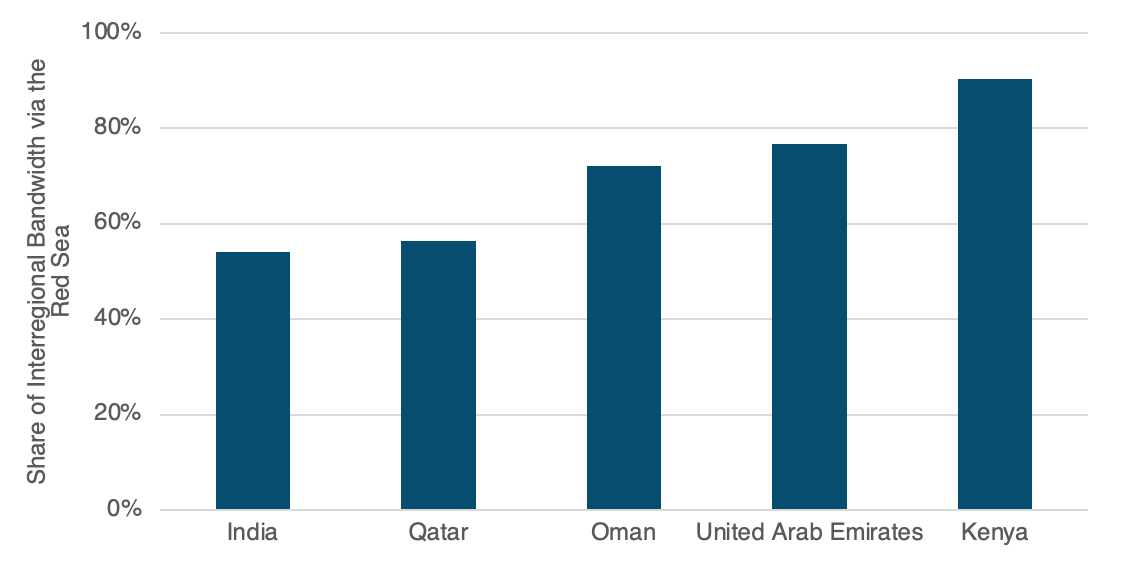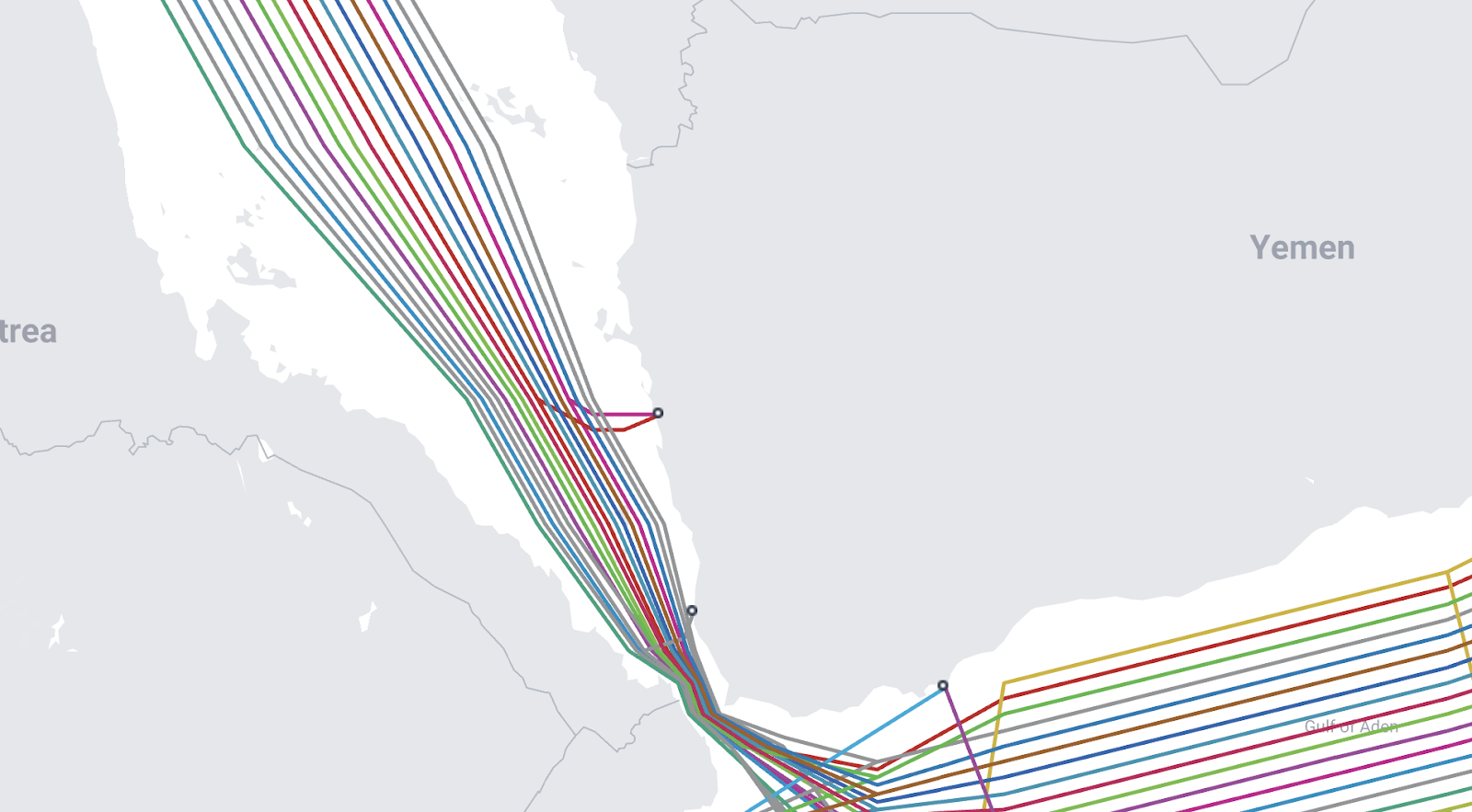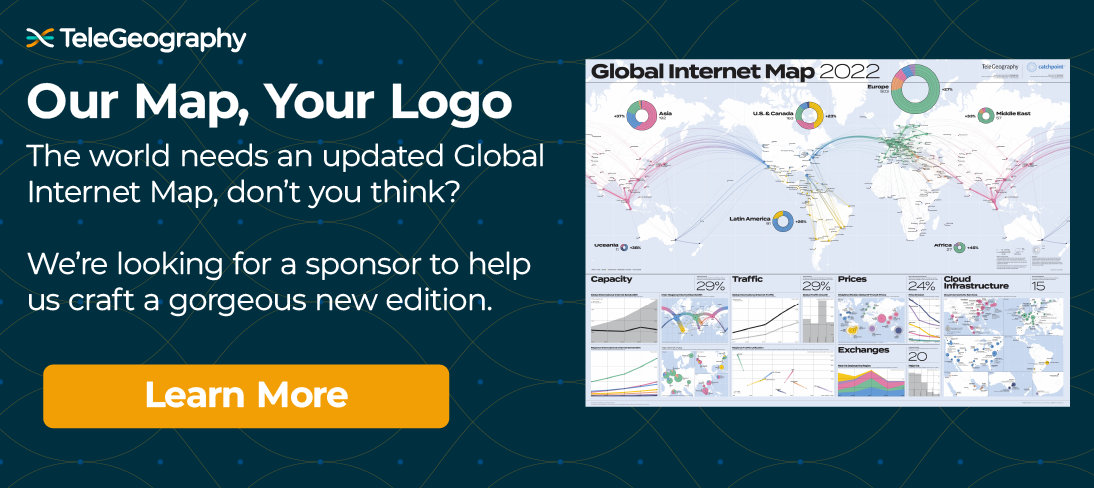The Red Sea is a global hot spot at the moment due to repeated attacks by Yemeni Houthi rebels against commercial shipping vessels.
While this inlet is a strategic location for global shipping, it also plays a vital role in global communications networks.
How important are the cables that lay on the bottom of the Red Sea?
Just look at the number of existing and planned cables near the Yemeni coast, where most attacks have been concentrated:
Existing and Planned Cables in the Southern Red Sea
Many Asian, East African, and Middle Eastern countries rely on Red Sea cables to access Europe.
We estimate that over half of many countries’ interregional bandwidth is connected to Europe via Red Sea cables.
According to TeleGeography’s latest data, we estimate that over half of many countries’ interregional bandwidth is connected to Europe via Red Sea cables. More broadly, over 90% of all Europe-Asia capacity is carried by cables in the Red Sea.
Share of Selected Countries’ Interregional Bandwidth via the Red Sea, 2023
 Source: © 2024 TeleGeography
Source: © 2024 TeleGeographyDeployment Delays
As the demand for international bandwidth continues to rise rapidly around the world, network operators are responding with investment in a large number of new cables. This includes several new projects in the Red Sea.
Even before the recent spate of rebel attacks on commercial shipping vessels, the Yemeni civil war created permitting headaches. Cable laying vessels require permits to enter a country’s territorial waters. When two different entities claim the same swath of sea, the situation becomes complicated.
The massive 2Africa cable, which is largely laid, has yet to realize deployment of a large length of cable that would lie in Yemeni waters. Other cables planned to traverse the Red Sea in coming years include IEX, Africa-1, Raman, and SeaMeWe-6.
Ensuring that these cables can be deployed is vital to meeting future demand requirements for East Africa, the Middle East, and India.
Repair Risk
With deployment of new Red Sea cables in question, the importance of existing cables is further increased. Routine maintenance and cable repairs are required to keep these cables up and running.
In November, Global Cloud Xchange was able to complete scheduled maintenance on the company’s FALCON cable in Yemeni waters. However, future repairs may prove difficult if cables are damaged in areas with high levels of rebel activity.
After all, even if a cable repair ship is permitted to enter the waters and recover the damaged cable, completing a delicate repair may be difficult. This often requires cable ships to stay in one area for days.
Were a stationary cable ship to be attacked in the midst of a repair, evasive maneuvers may not be possible. Cable ship operators may therefore decide that these repairs are not worth risking their vessels and crew.
Avoiding the Red Sea?
What happens if damage occurs to Red Sea cables that cannot be immediately repaired? In most cases, data can continue to flow using alternative systems and routes.
Gulf countries could access Europe via terrestrial network links to Saudi Arabia. India has links eastward to Singapore. East African countries could divert traffic up the West Coast of the continent. But you cannot quickly and completely reroute all existing traffic along other paths.
Imagine the impact of rerouting traffic from a closed six-lane highway to a two-lane road. Network quality would suffer depending on the number and capacities of cables damaged.
Hopefully, the situation in this part of the world will stabilize in the near-term. Until then, risks will persist for existing and planned cables in the Red Sea.
Alan Mauldin
Alan Mauldin is a Research Director at TeleGeography. He manages the company’s infrastructure research group, focusing primarily on submarine cables, terrestrial networks, international Internet infrastructure, and bandwidth demand modeling. He also advises clients with due diligence analysis, feasibility studies, and business plan development for projects around the world. Alan speaks frequently about the global network industry at a wide range of conferences, including PTC, Submarine Networks World, and SubOptic.
-1.jpeg?width=1280&name=AdobeStock_276596166%20(1)-1.jpeg)





